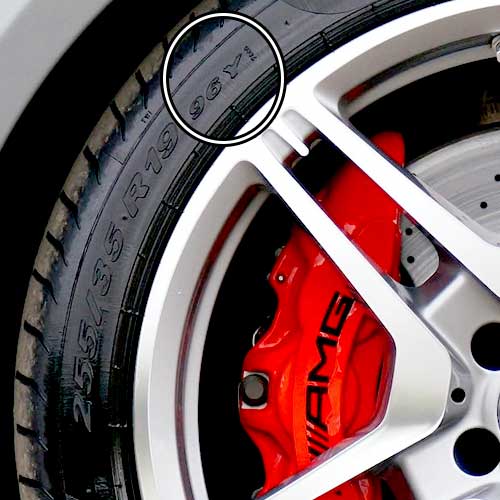Speed rating of the tire is denoted by letters, like T, H, V, W, and so on. These alphabets are assigned to indicate the maximum speeds a tire can be driven on ideally. But there is a little more to that.

With rolling of the tire, heat is produced, this damages the tire. But some tires are made more resistant to this heat than others, so they are assigned with Letters indicating higher Speed rating. The smallest rating is assigned by the letter L (which means up to 75 mph), while the largest speed rating Z which is mostly assigned to high performance tires tells you that you can drive a tire above 186 mph.
Same kind of thing goes for the Load Index.
Where is Speed Rating on the tire?
Speed rating of the tire is found on it’s sidewalls. Check out the image, where it says 96 Y. Here Y is the speed rating, while 97 refers to the tire’s load rating.
Following is the speed rating chart where you can match the tire’s letters to find the maximum speed it’s rated for.
Speed Rating Chart
| Speed Ratings | Max Speed (mph) | Max Speed (km/h) | Vehicle Type |
| L | 75 | 120 | Off Road/ Light Truck |
| M | 81 | 130 | Spare Tire |
| N | 87 | 140 | Spare Tire |
| Q | 99 | 160 | Winter/ 4×4 |
| R | 106 | 170 | Heavy Duty/ Light Truck |
| S | 112 | 180 | Sedan/ SUV |
| T | 118 | 190 | Sedan/ SUV |
| U | 124 | 200 | Sedan/ SUV |
| H | 130 | 210 | Sport Sedans |
| V | 149 | 240 | Sports Car |
| Z | 149+ | 240+ | Sports Car |
| W | 168 | 270 | High End Sports Car |
| Y | 186 | 300 | High End Sports Car |
| (Y) | 186+ | 300+ | High End Sports Car |
Why can’t tires with lower speed rating go faster?
As the tire rolls, heat is generated, much like when you rub your hands together in winter.
With heat, a tire rubber softens itself and it can break apart. But different tires have different durability and heat bearing capacities.
So a better speed rated tires is more capable of cooling itself down, but if you take them above the limit, the tire won’t be able to cool down faster than it’s heated up and can blowout.
So is this rating only related to speed?
No, not really, speed rating of a tire also affects other factors, like ride quality, handling performance and wear.
A higher speed rated tire would have better traction values as it would show smaller braking distances and better cornering abilities.
But note that with higher speed rating, the tire would have more rolling resistance, so this will affect the wear of the tire as well as fuel economy. Usually smaller speed rating help with fuel economy. But make sure you get tires with speed rating your car manufacturer recommends.
Should I get H or V rated tires?
Both V and H rated tires provide good performance in case of all season tires. The V rated tire with higher speed rating, is going to be stiffer, but they will perform better in term of grip and handling.
On the other side, the H rated tires, with smaller speed rating, would offer better fuel economy as these tires would have lesser rolling resistance in comparison.
Putting Tires With Different Ratings
No, it’s not wise to do so. Putting different speed rated tires can affect the car’s handling performance to a great extent.
But still if you must, you can put same tires at front and same in the back, but keep this temporary, and make sure the minimum speed rating a tire has.
More from Tips and Guide: https://tiredriver.com/tips-and-guide/
Take Home Points
So, a speed rating is not just about speeds but it tells you about how fast you can take your tire up to. With higher speed rating, the the tire gets better grip so overall handling performance is improved.
But with more grip comes more rolling resistance, or in other words, the tire takes more energy to roll, so that would mean more fuel consumption.
It would also affect the tread wear of the tire, as with more rolling resistance, the rib would rub with the surface it’s on with greater force.